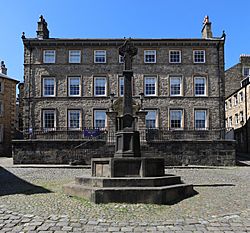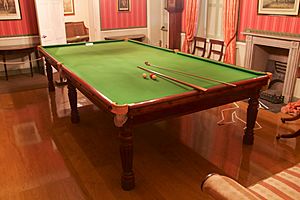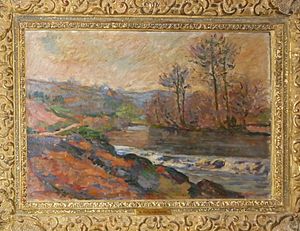Judges' Lodgings, Lancaster facts for kids
Quick facts for kids Judges' Lodgings, Lancaster |
|
|---|---|

Entrance front of the Judges' Lodgings
|
|
| Location | Castle Hill/Church Street, Lancaster, Lancashire, England |
| Restored by | SD 475 619 |
| Architectural style(s) | Georgian |
|
Listed Building – Grade I
|
|
| Designated | 22 December 1953 |
| Reference no. | 1298414 |
| Lua error in Module:Location_map at line 420: attempt to index field 'wikibase' (a nil value). | |
The Judges' Lodgings in Lancaster, England, is a very old building. It used to be a fancy house where important judges stayed. Now, it's a fun museum! It's the oldest house of its kind in Lancaster and was even the first to have window shutters. This special building is protected as a Grade I listed building, meaning it's super important historically.
Judges stopped using the house in 1975. After that, it became a museum. Today, it has a museum of childhood and a collection of amazing furniture made by a local company called Gillows. For a while, the museum's future was uncertain, but it reopened in April 2018. It has been welcoming visitors ever since.
Contents
A Look Back: The History of Judges' Lodgings
Early Days and Roman Finds
There's proof that other buildings stood here long ago. In the garden, people found parts of a Roman kiln, which was like an oven for pottery. The very first house on this spot was probably made of wood. Later, it was rebuilt with stone. Some think a house built in 1314 for Robert de Holland might have been here. The oldest parts of the current house are from the 1550s, like a huge stone fireplace in the entrance hall.
The Current Building's Story
The main building you see today was built around 1625. It even reused some old wooden beams and might sit on older foundations. By 1639, Thomas Covell, who was the Mayor of Lancaster and in charge of Lancaster Castle, owned the house. This building was known as the "Old Hall" of Lancaster. For many years, it was a place for judges to stay when they came to hear cases at the Assizes court in Lancaster Castle. Records show it was used by judges as early as 1635.
During the English Civil War in 1643, Lancaster was badly damaged by Royalist soldiers. Around 1662, Thomas Cole, a local official, bought the property. The house was made bigger and changed in 1675, and this new part was called "New Hall." In 1826, the county's magistrates bought the house. They added an extension and made more changes.
From Judges' Home to Museum Fun
Judges stopped using the house in 1975. After that, it was turned into the museum we know today. It now features a Museum of Childhood, which is full of old toys and games. There's also a fantastic collection of furniture made by the famous Lancaster company, Gillows.
Saving the Museum: A Community Effort
In 2015, the local council thought about closing five museums in Lancashire, including the Judges' Lodgings. This was because of money cuts. Many people were upset, and a group called "Friends of the Judges' Lodgings" was formed to try and save it. The closure was delayed a few times.
The museum did close for a short period in 2016. However, talks began with new groups to help run it. In April 2018, the council announced that the museum would reopen to the public for parts of 2018 and 2019.
Reopening and Recent Times
In March 2019, the Lancaster Judges' Lodgings officially reopened. It was run by a mix of paid staff and volunteers. Many visitors, both from out of town and local residents, were excited to see the museum open again. The museum and its "Friends" group put on many events, making it a very successful year.
However, in 2020, many planned events were put on hold because of the COVID-19 pandemic. The museum's opening was delayed until late August 2020. It reopened on August 28, 2020, but visitors had to book their visits in advance.
The Building's Look: Architecture
The Judges' Lodgings is built from sandstone with fancy stone decorations and slate roofs. It has a U-shape. The front entrance faces west and looks balanced. It has three floors, a basement, and seven sections (called bays). The style is Georgian, which was popular in the 1700s. The doorway has Tuscan columns that hold up blocks carved with lion heads. Above that is a decorative band with flowers and a curved top section that holds a painting of Lancashire's coat of arms.
Amazing Collections Inside
Gillows Furniture: A Legacy of Craftsmanship

The museum has a huge collection of Gillows furniture. Some pieces are shown in a special museum about the company. Other rooms are decorated with Gillows furniture to show how people lived long ago.
Robert Gillow started making furniture around 1727, even before the famous Thomas Chippendale. He made furniture for wealthy families. His sons, Richard and Robert, took over the business. Richard managed the workshop in Lancaster, and Robert opened a showroom in London. It was rare for a company outside London to have a London shop! The Gillow family sold the company in 1813, but the new owners kept the name Gillow & Co. Famous writers like Jane Austen and Thackeray even mentioned Gillows furniture in their books.
Many pieces of furniture at the Judges' Lodgings were made for specific customers. Gillows kept detailed "Estimate Sketch Books," which are now in an archive in London. They made their own designs and also built furniture for other designers. They even worked for famous designers like Chippendale and Sheraton.
In the 1760s, Gillows started making billiard tables. Some people even say they invented the billiard table, though billiards had been played for a long time. They are also known for creating the "telescopic" (extendable) dining table and the first Davenport desk.
By 1900, the company offered a full interior design service. This was a lot of work, and the company was bought by Waring of Liverpool in 1903. The new company, Waring & Gillow, continued, but it never had the same amazing reputation for quality. The company closed in 1962, and the Lancaster workshops shut down. During wartime, Gillows even helped build parts for airplanes like the Mosquito!
Bruce James Talbert's Designs
In the 1860s and 1870s, Gillows worked with a designer named Bruce James Talbert. He was known for his Gothic Revivalist style. Gillows made many furniture items based on Talbert's designs. Two of his sideboards from around 1872 are on display at the Judges' Lodgings.
Talbert wrote a book in 1867 about applying Gothic styles to furniture. This book was very important for furniture makers. He suggested using strong frames, decorative inlays, and carvings. His designs were shown at big international exhibitions. Many companies made furniture in his Medieval and Jacobean styles. His designs often had lots of detail, like bold geometric patterns, tiny carved squares, and rows of small turned spindles. Some pieces even had carved poems with moral messages.
You can clearly see Talbert's style in the sideboards at the Judges' Lodgings. One of them, called the Dundee Cabinet, was made by Gillows from his designs. It has his special carved squares, geometric patterns, and rows of spindles. This cabinet is made of stained baywood with inlaid panels of thuya and boxwood. Another sideboard in the butler's pantry is made of oak with boxwood panels.
Artistic Treasures: Paintings
English Paintings
The museum also displays some important paintings by George Romney. Romney was born nearby and kept in touch with Lancashire even after moving to London. He painted local important people and bought picture frames from Gillows. A portrait of Abraham Rawlinson, who was a Member of Parliament for Lancaster in the 1780s, hangs in the entrance hall. It was bought in 2006. There are also paintings by Joseph Wright of Derby and Sir Thomas Lawrence.
French Paintings
There is a collection of six French paintings, given to the museum by Lionel Hewlett. This includes two beautiful landscapes by the Impressionist artist Armand Guillaumin. One shows the river Creuse, and another shows the Île de Ré. You can see how his friend Van Gogh influenced his work.
Step Back in Time: Museum of Childhood
The Museum of Childhood is a highlight! It has a recreated nursery with an amazing three-seater rocking horse. There's also a classroom set up to look like one from the past. A big part of the collection is the Barry Elder collection of dolls, bought in 1976. It includes many types of dolls, like peg dolls, felt dolls, wax dolls, and porcelain dolls from famous makers. In the display cases, you can see doll's houses, Lego, Meccano, and even some Hornby railway trains.
See also
- Grade I listed buildings in Lancashire
- Listed buildings in Lancaster, Lancashire



